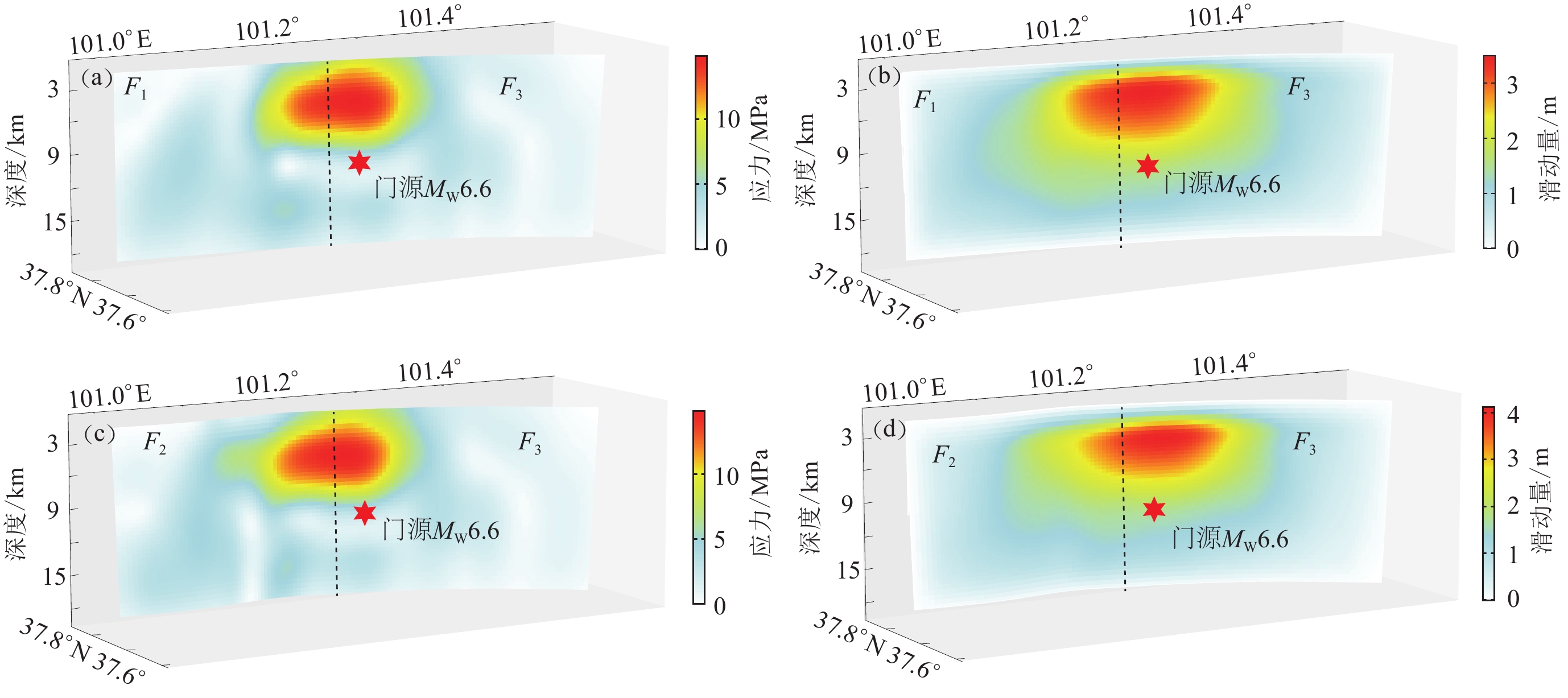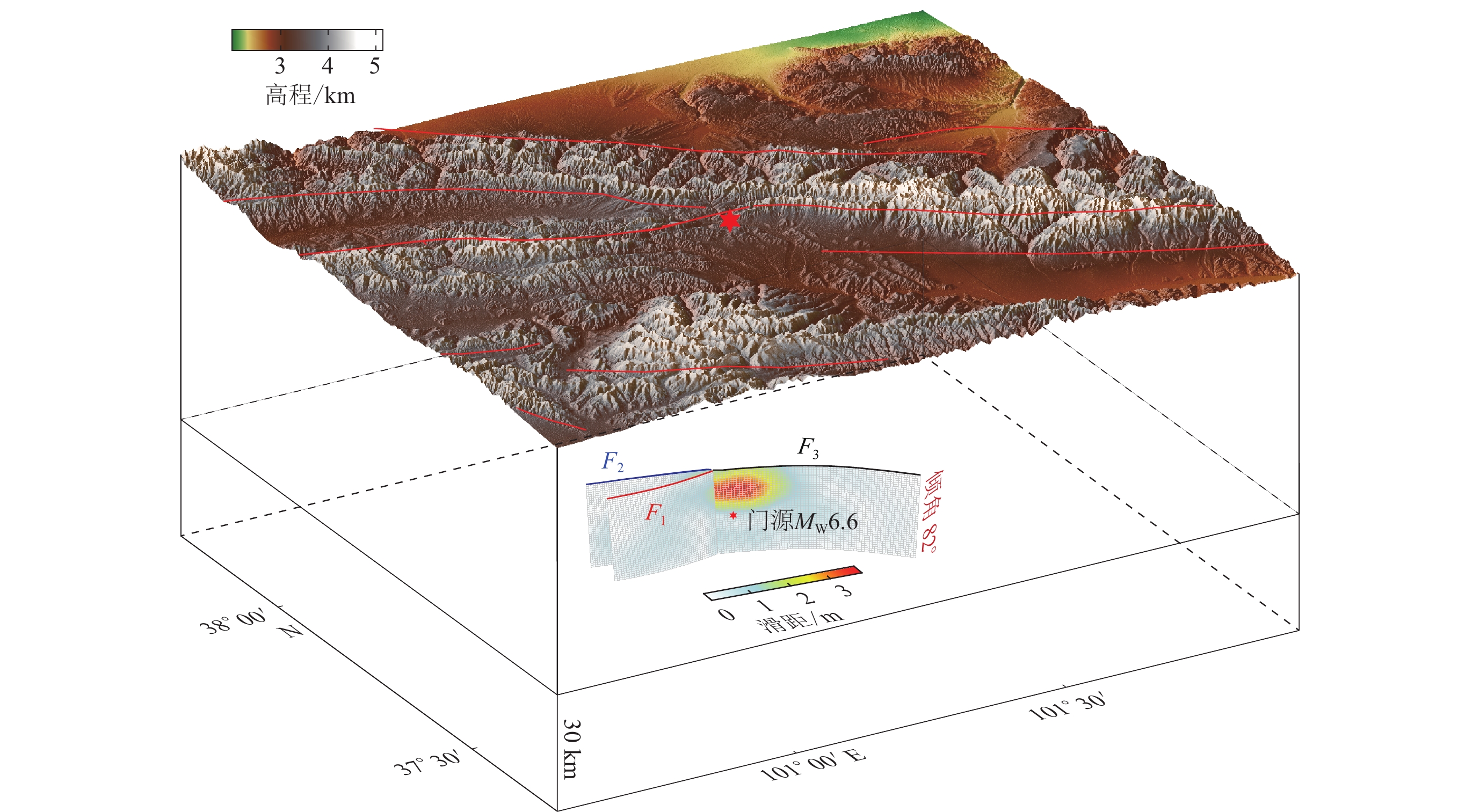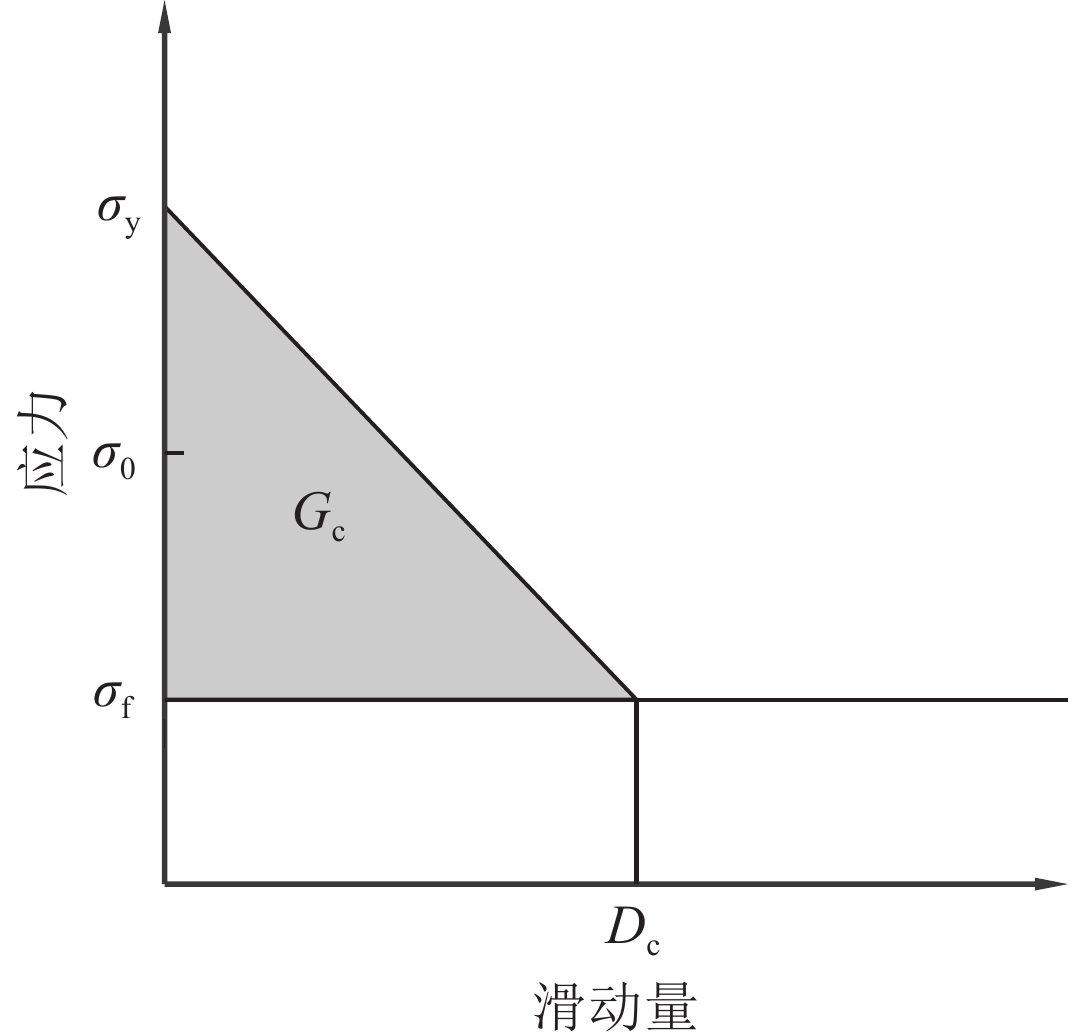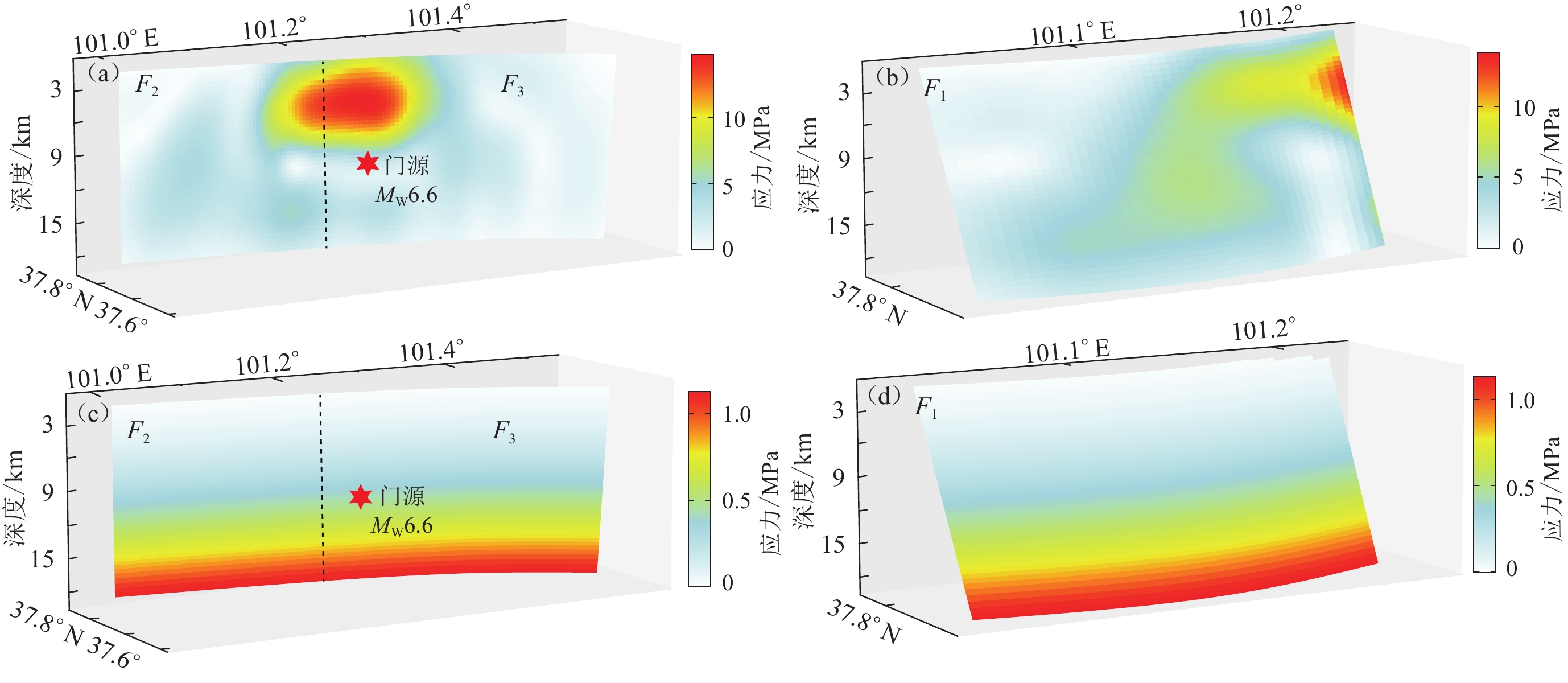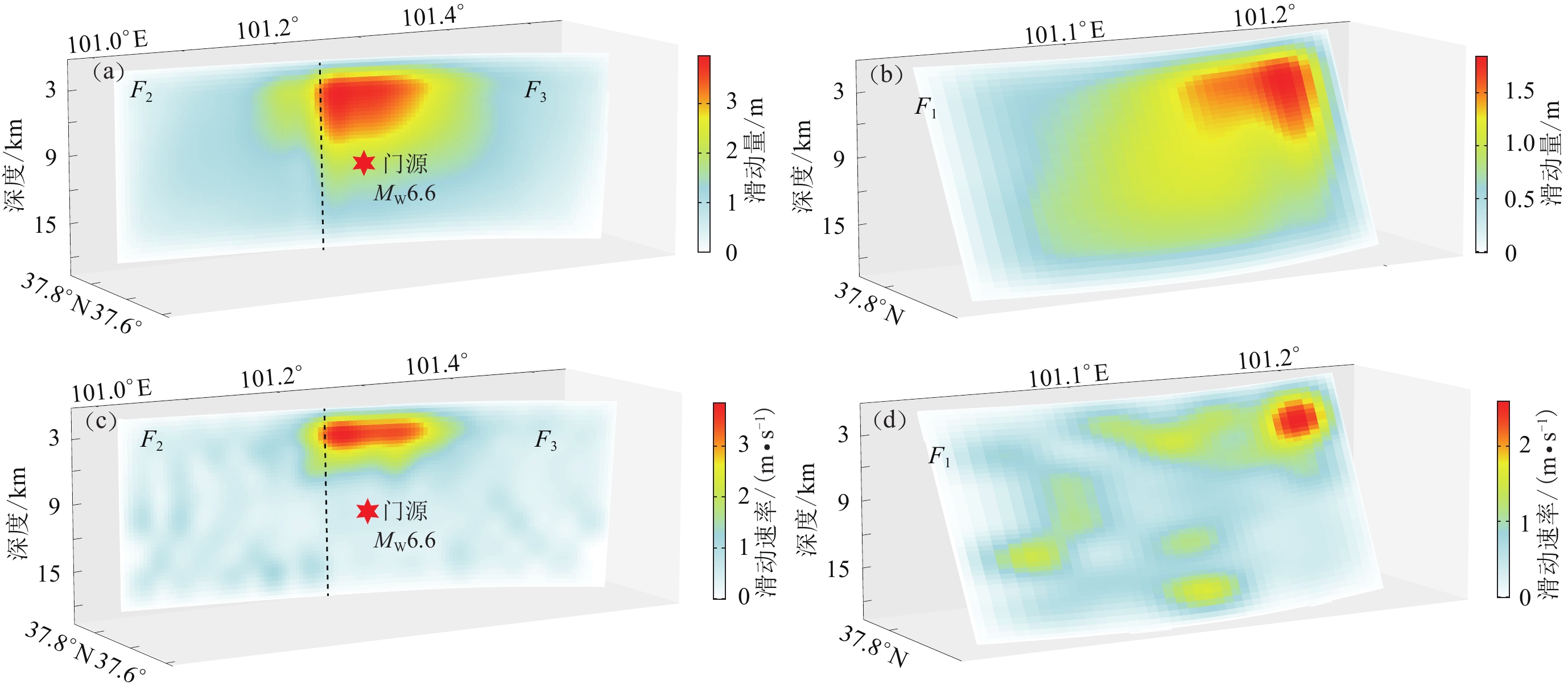Dynamic source rupture process of the 2022 Menyuan MW6.6 earthquake,Qinghai Province
-
摘要:
2022年1月8日青海门源MW6.6地震在地表产生了较强的破坏,为研究门源地震产生强地表破裂及阻碍托莱山东段应力释放的构造背景,本文采用谱元法模拟了门源地震曲面分支断层在实际地形下的动力学破裂过程。结果显示,破裂自初始破裂点沿断层上倾方向同时发生双侧破裂;受震源区上方高速P波异常体的影响,断层产生非连续破裂。在破裂传播到托莱山东段时,断层的滑动速度和滑动量发生明显的阶跃式下降;此外,近地表处滑动速率约3.6 m/s的区域可能为强地面运动生成区。以上两者产生的高频辐射共同作用可能是此次门源地震同震地表形变较强的主要原因。由动力学模拟结果计算得到的应变空间分布显示,托莱山东段南西侧与冷龙岭西段北东侧的应变以拉张为主,而冷龙岭西段南西侧的应变以挤压为主,这与门源地震震源机制解结果、门源地震所处的青藏高原东北缘北东向主压转为南西向迁移所处的构造背景以及ENE和WSW的震源区应力场方向一致。托莱山断裂东段受分支断层破裂过程的强烈抑制作用,其累积应力未完全释放,残留震级约为MW5.1,在门源地震库仑应力的触发作用下,未来有进一步破裂的可能。
Abstract:On January 8, 2022, a significant earthquake with a magnitude of 6.6 struck Menyuan, Qinghai, which resulted in substantial surface damage. To investigate the geological context behind the strong surface rupture generated by the Menyuan earthquake and its impact on the inhibition of stress release in the eastern section of the Tuolaishan fault, the spectral element method was employed in this study to simulate the dynamic rupture process of the branching fault on actual terrain. The dynamic rupture simulation revealed that the rupture was initiated bilaterally along an upward direction from the initial rupture point. Under the influence of a high-speed P-wave anomaly located above the source area, the rupture displayed a non-continuous pattern. With the progression of the rupture into the eastern section of Tuolaishan, a significantly abrupt decrease occurred in both slip rate and slip. Furthermore, the area with a slip rate of around 3.6 m/s near the surface of the Earth could be considered as a strong motion generation zone. The combined influence of these factors, along with their high-frequency radiation, might have played a pivotal role in the pronounced coseismic surface deformation during the MW6.6 earthquake in Menyuan. As calculated from the dynamic simulation results, the spatial distribution of strain suggested that the southwestern side of the eastern section of Tuolaishan and the northeastern side of the western section of Lenglongling experienced predominantly tensile stress, with corresponding areas subjected to compression. This observation aligns with the focal mechanism solution and the geological context of the northeastern margin of the Qinghai-Tibet Plateau, where the direction of principal compressive stress transitions from north-south to southwest-northeast. Furthermore, the dynamic rupture process in the eastern section of Tuolaishan was strongly inhibited by the rupture of the branching fault. This led to incomplete stress release and a residual seismic magnitude of approximately MW5.1. Under the trigger of Coulomb stress from the Menyuan earthquake, further rupture in the future is possible.
-
Keywords:
- 2022 Menyuan earthquake /
- dynamic rupture /
- spectral element method /
- Coulomb stress
-
引言
局部场地条件对地震动的影响一直是地震工程领域的研究热点。 场地条件对地表地震动会产生明显的影响,是确定设计地震作用的关键因素。 对于土层场地,研究人员一般从土层厚度、 土层结构、 土的动力学参数等方面研究场地覆盖土层对地震动的影响; 对于局部地形,一般从地形的几何尺寸、 物质组成、 结构构造、 入射地震动特性等方面展开数值模拟分析。 强震动观测的对象也多以土层场地为主,专门针对山体地形的观测台阵较少,一般很少将二者对地震动的影响加以对比分析,而在某一局部范围内对土层场地和山体地形同时进行强震动观测的研究更是鲜有开展。 大型工程,例如大跨度桥梁选址时,桥墩往往位于不同的地貌单元,在抗震设计过程中就需要考虑地震动的多点输入问题; 如果桥墩分别位于土层场地和山体上,则两种局部场地条件的地震动效应差异势必会影响桥梁的响应。 Yu等(2014)对芦山地震动记录进行分析的结果表明,随着断层距的增加,山区的地震动衰减速度明显大于平原地区。 在土层场地和相邻山体布设强震动观测仪组成观测台阵,就能够对这两种局部场地的地震动效应差异进行很好的观测,因此基于强震动观测记录,研究局部范围内土层场地与山体地形之间的地震动效应差异是有意义的。
傅里叶谱比法首先由Borcherdt(1970)提出,采用场地及其附近参考场地之间地震动记录进行傅里叶谱幅值比分析. 该方法原理简单,处理数据方便,广泛应用于具有参考场地台阵的地震动场地效应研究(Davis,West,1973; Celebi,1987; Geli et al,1988; Bouchon et al,1996)。 Geli等(1988)通过试验和理论分析,认为之前关于地形对地震动影响的研究结果只是在定性方面具有一致性,而数值模拟结果总是低估实际观测值。 DavisWest(1973)和利用傅里叶谱比法对山体的地形效应地震动记录进行分析,结果显示时域内的峰值加速度比通常远小于频域内的傅里叶谱幅值比。 Sánchez-Sesma等(1986)采用均方根傅里叶谱比法衡量山体地形对地震动的影响,Paolucci(1999)则对地震动记录中不同分量交叉偶联效应对地震动记录傅里叶谱幅值比的影响进行了研究。 基于自贡西山公园地形影响台阵获得的2008年汶川主震记录,王海云和谢礼立(2010),杨宇等(2011)以唐晖等(2012)分别利用傅里叶谱比法和H/V谱比法对自贡西山公园的山体地震动放大系数进行了分析。
本文拟基于自贡西山公园地形影响台阵在汶川地震中获得的主震记录,以及唐山响堂土层场地台阵获得的地震动记录,采用互相关分析、 相干分析、 传统傅里叶谱比法和考虑相干系数的傅里叶谱比法,对地形台阵中不同高度的台站和场地台阵中不同深度的观测点之间的地震动记录分别进行分析,以对比研究山体地形与土层场地两种局部场地条件对地震动场地效应的影响问题。
1. 强震动观测台阵简介
自贡西山公园地形影响台阵(以下简称为自贡地形台阵),位于四川盆地南部的自贡市自流井区西山公园内,为“十五”国家重大项目“中国数字地震观测网络”中的固定台阵。 为获取反映地表地形对地震动影响的多点实测数据,台阵在水平自由地表场地、 山脚、 山底及山脊等位置布设了8个观测点,其中0号测点为地表土层测点,1号测点为山底基岩测点,其余测点为山体基岩测点,各测点位置如图 1所示(王伟等,2015)。
![]() 图 1 自贡地形台阵测点位置示意图(王伟等,2015)Figure 1. Location schematic diagram of observation points in the Zigong topography array(after Wang et al, 2015)
图 1 自贡地形台阵测点位置示意图(王伟等,2015)Figure 1. Location schematic diagram of observation points in the Zigong topography array(after Wang et al, 2015)唐山响堂土层场地台阵始建于1992年,位于河北省唐山市滦县响堂乡杜峪村,是我国用于研究局部场地条件影响的第一个专用井下台阵,由1个基岩测点、 2个地表土层测点和3个井下测点(深度分别为16.0 m,32.0 m,47.0 m)组成。 图 2为响堂土层场地台阵测点分布剖面图,其中1号和2号测井的局部场地条件列于表 1。3号测井始建于1997年,2000年12月初投入试运行,并于2001年6月安装普通市话线路,实现了北京强震观测中心与响堂井下台阵之间的有线遥测功能,使该台阵成为我国第一个具有遥测功能的局部场地条件影响台阵(卢滔等,2006)。
![]() 图 2 响堂土层场地台阵测点分布剖面图(卢滔等, 2006)Figure 2. Distribution of monitoring points in the Xiangtang soil site array (after Lu et al, 2006)表 1 响堂土层场地台阵中1号和2号测井的场地条件Table 1. Site conditions of the boreholes No.1 and No.2 in Xiangtang soil site array
图 2 响堂土层场地台阵测点分布剖面图(卢滔等, 2006)Figure 2. Distribution of monitoring points in the Xiangtang soil site array (after Lu et al, 2006)表 1 响堂土层场地台阵中1号和2号测井的场地条件Table 1. Site conditions of the boreholes No.1 and No.2 in Xiangtang soil site array层号 岩性 层厚/m 层底深度/m 波速/(m·s-1) 1 粉质黏土 4.78 4.78 249 2 细砂 2.45 7.23 270 3 粉土 0.85 8.08 249 4 黏土 4.19 12.27 249 5 强风化黑云变粒岩 6.02 18.29 538 6 强风化花岗质混合岩 13.62 31.91 552 7 中风化花岗质混合岩 0.40 32.31 552 本文分析使用的地震动记录,主要采用自贡地形台阵获得的2008年汶川MS8.0地震主震记录1组,以及响堂土层场地台阵1号和2号测井获得的1994年9月3日MS1.6地震的地震动记录1组。
2. 台阵记录的互相关分析和相干系数分析
互相关函数是描述信号x(t)某一时刻的取值与信号y(t)另一个时刻的取值之间的相关程度,表示为

式中,rxy(τ)为互相关函数,T为信号总持时,τ为时延.
对于两个能量有限的离散信号x(n)和y(n),经过互相关分析得到的rxy(τ)即为二者之间的互相关系数。 互相关分析可以研究系统的时间滞后性质、 系统输入信号与输出信号的互相关函数以及台阵中两个台站测点之间地震波传播的时间延迟。 对自贡地形台阵和响堂土层场地台阵的地震动记录进行基线校正和滤波处理,基线校正采用Boore(2001)的一次多项式方法,滤波采用巴特沃斯(Butterworth)带通滤波器,频带范围为0.1—25.0 Hz,校正后的记录基线漂移现象消除,满足使用要求。
对自贡地形台阵0—7号测点的地震动加速度依次进行互相关分析,考虑到EW,NS和UD方向的互相关分析结果类似,仅将EW向的互相关系数结果示于图 3. 可以看出,自贡地形台阵的0—5号测点,其地震动加速度的互相关系数极低,表明地震波在0—5号中的相邻测点之间的地震动特性变化显著,差异性很大。 由互相关函数的定义可知,对于3个变量x(t),y(t)和z(t),如果x(t)与y(t),y(t)与z(t)的互相关系数很大,则x(t)与z(t)的互相关系数也一定很大. 例如,图 3中5号与6号测点的互相关系数r5-6和6号与7号测点的互相关系数r6-7的最大值分别为0.84和0.82,5号与7号测点的互相关系数r5-7的最大值则为0.76,表明5号、 6号与7号测点之间地震动相关性显著。
![]() 图 3 自贡地形台阵1—7号测点EW向加速度互相关系数r0-1表示0号与1号测点的互相关系数, 以此类推, 下同Figure 3. Cross-correlation coefficients of the EW accelerations for the observation points Nos.1-7 of the Zigong topography array r0-1 is the cross-correlation coefficient between the observation points No.0 and No.1, and so on, the same below
图 3 自贡地形台阵1—7号测点EW向加速度互相关系数r0-1表示0号与1号测点的互相关系数, 以此类推, 下同Figure 3. Cross-correlation coefficients of the EW accelerations for the observation points Nos.1-7 of the Zigong topography array r0-1 is the cross-correlation coefficient between the observation points No.0 and No.1, and so on, the same below自贡地形台阵中地表土层0号测点和山底基岩1号测点分别与其它山体测点地震动的互相关分析结果分别如图 4和图 5所示。 可以看出,虽然0号测点位于地表土层场地,但其与山体测点之间的互相关系数明显大于1号山底基岩测点与其它山体测点之间的互相关系数。 这是由于,与1号山底基岩测点相比,0号地表土层测点与其余山体基岩测点的位置处于相似的地震波场环境。 如果山体地形的存在对山脚基岩位置处的入射地震波产生反射、 折射及衍射等影响,那么1号测点与其余山体基岩测点地震动的相关性应该是显著的; 而图 5中该相关性极低,这表明山体地形的存在对山底基岩位置处的地震动影响很小,并且进一步证明了Blume(1969,1972)通过对地下人工核爆破条件下与建筑物不同距离的场点地震动反应的对比分析,认为建筑物的存在对其周围场地地震动反应影响很小的结论。
相干函数,又称为凝聚函数,其表达式为

式中,cxy(f)为相干函数,Pxy(f)为互功率谱,Pxx(f)和Pyy(f)分别为两个信号的自功率谱。 相干函数反映了两个信号进行互功率谱计算中外来不相干影响的大小,相干系数越大表示受外来影响越小。 对自贡地形台阵测点的EW向地震动加速度进行相干系数分析的结果如图 6所示。 可以看出,自贡地形台阵中0—5号测点的相干系数很小,表明各测点之间受外来信号影响较大. 由于山体地形的起伏变化,这些测点的局部地形差异很大,因此地震动特性变化显著,结合图 3中1—5号测点之间的互相关系数较小的特点,进一步说明这些测点之间的地震动相对独立。 就测点之间的相干系数所对应的频段范围来看,c0-1和c1-2在全频段范围内均小于0.2; c2-3,c3-4和c4-5在5.0 Hz以下频段总体稍高于5.0 Hz以上频段; 5—7号测点在5.0 Hz以下频段的相干系数突然增大,整体明显高于5.0 Hz以上频段,表明这3个测点的地震动在该频段范围内相干性很强. 另外,考虑到5—7号这3个测点之间的地震动互相关系数很大,即地震波在山顶测点之间发生传播,因此将5号和7号测点作为地震动输入,最高的6号测点作为输出,得到相应的傅里叶谱幅值比S6/S5和S6/S7,如图 7所示。
由图 7可知,山顶测点之间的傅里叶谱幅值比在5.0 Hz以下的放大系数约为1.0,即没有明显的放大效应。 导致这种现象的原因,一方面是在山体基岩中传播的地震波中5.0 Hz以下的波长较长; 另一方面,5—7号测点位于山顶,山顶的尺寸相对底部显著变小(图 1),因此该频段范围对应的较长波长的地震波很容易在山顶附近位置发生衍射,从而导致山顶测点的地震动在该频段范围内的相干系数很大,而傅里叶谱幅值没有明显放大。 在5.0—6.0 Hz的频段范围内,放大系数有明显提高,最大值可达1.70,其原因是地震波在该频段范围的频率成分与山顶的自振频率相当,从而发生共振效应; 6.0—25.0 Hz范围内的傅里叶谱幅值比显著小于1,说明山顶对该频段范围内的地震动产生了明显的压制作用。
对自贡地形台阵的地表土层0号测点与山体基岩测点在EW向地震动加速度进行相干系数分析,结果如图 8所示。 可以看出,自贡地形台阵中0号与1号测点的相干系数在所有频段范围均极小; 0号测点与其余山体基岩测点之间的相干系数在0—2.0 Hz频段范围内明显大于2.0 Hz以上频段. 这正好可以解释图 4中0号测点与这些测点相关性显著的现象,即入射地震波中2.0 Hz以下频段范围对应的波长较长,其很容易穿过土层场地和山体地形发生衍射,导致这两种局部场地条件下的地震动显著相关. 在2.0 Hz以上的频段范围,0号测点与其余基岩测点之间的相干系数显著降低,表明土层场地与山体地形这两种不同的局部场地条件对较高频率的地震波会产生明显不同的场地效应。
3. 山体地形台阵记录的傅里叶谱分析
王伟等(2015)关于自贡地形台阵地表土层测点与山体测点EW,NS和UD向3个分量的加速度傅里叶谱进行研究的结果显示,对于相同分量,各测点在2.0 Hz以下的低频段傅里叶谱幅值有较好的吻合. 该现象与地表土层测点与山体基岩测点以及山体基岩测点之间地震动在低频段范围互相关系数、 相干系数较大的分析是一致的,即低频段地震波增加了土层场地和山体地形地震动的相关性和傅里叶谱幅值的一致性。 随着测点高程的增加,在2.0—5.0 Hz范围内,傅里叶谱幅值明显变大,且傅里叶谱幅值差异性显著增大. 根据地震动互相关分析和相干系数分析可知,这是由于土层场地和山体地形不同位置对地震动中高频成分的场地效应差异性所致。 地表土层测点相对于其它山体基岩测点,在5.0—9.0 Hz的频段范围内出现明显峰值,下面分析出现这种现象的原因。
自贡地形台阵的地表土层场地地震动幅值较小,处于线弹性状态,且其底部无竖井台阵,考虑到场地条件的相似性,决定采用响堂土层场地台阵1994年9月3日MS1.6地震的地震动记录分析场地不同深度地震动的傅里叶谱幅值比. 为了避免台阵中不同深度土层下行反射波波场与上行波场发生相消干涉,导致参考场地的地震动傅里叶谱在特定频段的幅值大大降低,产生谱洞,并在其中出现假共振现象(王海云,2014),本文采用Steidl等(1996)提出的考虑相干系数的傅里叶谱比法对响堂土层场地台阵地震动记录进行数据处理,分析土层场地对地震动的放大效应机制。 EW,NS和UD向不同深度的加速度傅里叶谱幅值比如图 9所示.
由图 9分析可知,对于竖井台阵3个分量不同深度的加速度傅里叶谱幅值比,绝大多数在0—5.0 Hz频段内较低,而在5.0 Hz以上的频段内显著增大; 这与台阵所处的土层场地条件有关,即覆盖层厚度较薄且剪切波速较高的场地,更有利于放大较高频率的地震波,而低频段地震波的波长较长,更容易穿过覆盖土层发生衍射现象,这就解释了自贡地形台阵地表土层0号测点地震动傅里叶谱在5.0—9.0 Hz频段内出现的峰值现象。
4. 讨论与结论
基于自贡西山公园地形台阵和唐山响堂土层场地台阵的地震动记录,进行地震动的互相关分析、 相干系数分析、 傅里叶谱比法和考虑相干系数的傅里叶谱比分析。 由于自贡西山公园中地表土层测点与山体基岩测点距离较近,其震源效应和传播路径效应基本一致,对入射地震波产生的影响主要是由于这两种局部场地条件自身差异所致。 对于山体测点,其位置分布在基岩上,因此对地震动的山体地形效应主要受山体局部几何形状、 尺寸和地震波入射角度等因素的影响. 如何考虑山体基岩上覆土层与山体基岩地形对地震动的耦合效应尚需进一步研究。 对山体地形台阵地震动记录分析显示,其地震动的互相关性和傅里叶谱形状的特点均与不同频段范围内的相干系数大小有较好的一致性。 通过上述分析,得出以下结论和建议: 1)土层场地和山体地形的地震动效应受地震波频率成分的影响显著. 对于自贡西山公园台阵中的这两种局部场地条件,由于低频地震波的波长较长,因此容易穿过场地土层和周边的山体地形发生衍射现象,并导致两种局部场地条件的地震动显著相关,该地震动特点在跨越土层场地和山体地形的大跨度桥梁抗震设计中必须考虑。 另外,这种低频地震波的类型和成因需要进一步研究。 这两种局部场地对地震波中较高频率成分的地震动影响机制不同,导致相应频段范围内地震动相干系数较低,即土层场地与山体地形在较高频段的地震动效应差异显著。
2)山体的顶部由于局部尺寸变小,地震波中的低频长波长地震波更容易发生衍射,导致山顶周边测点的地震动在低频段的相关系数和相干系数增加; 较高频段的地震波则容易在山顶位置引起共振效应。
3)山体地形上相邻位置的地震动差异性一般较大,且相关性低,这与山体地形不同位置的几何形状差异有关; 山底基岩与其余山体基岩测点地震动的互相关分析和相干系数分析表明,山底的地震动受山体地形的影响较小,该位置的地震动效应机制尚需进一步研究。
-
图 8 两种断层模型及其动力学模拟结果
图(a)和 (b)分别为F1,F3的初始应力和模拟结果;图(c)和 (d)分别为F2,F3的初始应力和模拟结果
Figure 8. Two fault models and their dynamic simulation results
Figs.(a) and (b) are the initial stresses and simulation results for F1 and F3,respectively;Figs.(c) and (d) are the initial stresses and simulation results for F2 and F3,respectively
图 1 门源MW6.6地震和研究区内历史强震分布(GCMT,2022)
黑点为余震震中分布(数据源自Fan et al,2022);红色实线为区域内活断层在地表的投影(数据源自徐锡伟等,2016);绿框为进行强地面运动模拟的范围
Figure 1. Distribution of the Mengyuan MW6.6 earthquake and historical strong earthquakes in the region (GCMT,2022 )
The black dots are the distribution of aftershock epicenters (data from Fan et al,2022);the red solid line is the projection of active faults on the surface in the region (data from Xu et al,2016);the green box is the range wherestrong ground motion simulations were performed
图 2 数值计算空间和包含实际地形的曲面分支断层模型(Yang et al,2022)
F1为托莱山断裂东段的分支断层;F2和F3为冷龙岭断裂的西段主断层
Figure 2. Numerical computational space and a curved surface branch fault model (Yang et al,2022) that includes actual terrain
F1 is the branch fault of easternTuolaishan fault;F2 and F3 are the main faults of the western Lenglongling fault
图 3 滑动弱化摩擦准则
$ {\sigma }_{\mathrm{y}} $:屈服应力;$ {\mathrm{\sigma }}_{0} $:初始应力;$ \mathrm{\sigma}\mathrm{_f} $:最终应力;Dc:滑动弱化距离;Gc:破裂能
Figure 3. A simple and typical slip-weakening friction law
$ {\mathrm{\sigma }}_{{\mathrm{y}}} $:yield stress;$ {\mathrm{\sigma }}_{0} $:initial stress level;$ {\mathrm{\sigma }}_{{\mathrm{f}}} $:final stress;$ {{D}}_{\mathrm{c}} $:critical slip-weakening distance;$ {{G}}_{\mathrm{c}} $:fracture energy
图 4 由运动学滑动量计算得到的静态应力降(a,b)和随深度变化的屈服应力(c,d)
图(a)和(c)为主断层F2、F3;图(b)和(d)为分支断层F1;黑色虚线为分支断层交切的位置,下同
Figure 4. Distribution of static stress drop (a,b) and yield stress (c,d) on the fault
Figs.(a) and (c) are main faults F2,F3;Figs.(b) and (d) are branching faults F1. The black dashed line shows the location of the branching fault intersection,the same below
图 7 动力学模拟计算得到的PGV (a)和门源地震仪器烈度(中国地震局工程力学研究所强震观测组,2022;尹晓菲等,2022)(b)
Figure 7. PGV obtained from dynamic simulation (a) and instrumental seismic intensity distribution of MenyuanMS6.9 earthquake (Strong Motion Observation Group,Institute of Engineering Mechanics,China Earthquake Administration,2022;Yin et al,2022)(b)
表 1 门源地震动力学破裂模拟采用的层状速度 结构(Fan et al,2022)
Table 1 Layered velocity structure used in the Menyuan earthquake dynamics rupture simulation (Fan et al,2022)
层数 vP/(km·s−1) vS/(km·s−1) 深度上边界/km 1 5.0 2.9 0 2 5.2 3.0 2.5 3 6.1 3.5 5.8 4 6.6 3.8 16.3 5 6.9 4.0 28.1 6 8.2 4.7 57.0 -
董森,张海明. 2019. 角度对于Y型分叉断层自发破裂传播过程的影响[J]. 地球物理学报,62(11):4156–4169. doi: 10.6038/cjg2019M0572 Dong S,Zhang H M. 2019. Effects of angles on dynamic ruptures on Y-type branched faults[J]. Chinese Journal of Geophysics,62(11):4156–4169 (in Chinese).
冯万鹏,何骁慧,张逸鹏,房立华,Samsonov S,张培震. 2023. 2022年青海门源MW6.6地震的发震断层及孕震构造模式[J]. 科学通报,68(2/3):254–270. Feng W P,He X H,Zhang Y P,Fang L H,Samsonov S,Zhang P Z. 2023. Seismic faults of the 2022 MW6.6 Menyuan,Qinghai earthquake and their implication for the regional seismogenic structures[J]. Chinese Science Bulletin,68(2/3):254–270 (in Chinese).
韩帅,吴中海,高扬,卢海峰. 2022. 2022年1月8日青海门源MS6.9地震地表破裂考察的初步结果及对冷龙岭断裂活动行为和区域强震危险性的启示[J]. 地质力学学报,28(2):155–168. Han S,Wu Z H,Gao Y,Lu H F. 2022. Surface rupture investigation of the 2022 Menyuan MS6.9 Earthquake,Qinghai,China:Implications for the fault behavior of the Lenglongling fault and regional intense earthquake risk[J]. Journal of Geomechanics,28(2):155–168 (in Chinese).
李振洪,韩炳权,刘振江,张苗苗,余琛,陈博,刘海辉,杜静,张双成,朱武. 2022. InSAR数据约束下2016年和2022年青海门源地震震源参数及其滑动分布[J]. 武汉大学学报•信息科学版,47(6):887–897. Li Z H,Han B Q,Liu Z J,Zhang M M,Yu C,Chen B,Liu H H,Du J,Zhang S C,Zhu W. 2022. Source parameters and slip distributions of the 2016 and 2022 Menyuan,Qinghai earthquakes constrained by InSAR observations[J]. Geomatics and Information Science of Wuhan University,47(6):887–897 (in Chinese).
李智敏,盖海龙,李鑫,袁道阳,谢虹,姜文亮,李永生,苏琦. 2022. 2022年青海门源MS6.9级地震发震构造和地表破裂初步调查[J]. 地质学报,96(1):330–335. Li Z M,Gai H L,Li X,Yuan D Y,Xie H,Jiang W L,Li Y S,Su Q. 2022. Seismogenic fault and coseismic surface deformation of the Menyuan MS6.9 earthquake in Qinghai,China[J]. Acta Geologica Sinica,96(1):330–335 (in Chinese).
梁宽,何仲太,姜文亮,李永生,刘泽民. 2022. 2022年1月8日青海门源MS6.9地震的同震地表破裂特征[J]. 地震地质,44(1):256–278. doi: 10.3969/j.issn.0253-4967.2022.01.016 Liang K,He Z T,Jiang W L,Li Y S,Liu Z M. 2022. Surface rupture characteristics of the Menyuan MS6.9 earthquake on January 8,2022,Qinghai Province[J]. Seismology and Geology,44(1):256–278 (in Chinese).
梁姗姗,雷建设,徐志国,邹立晔,刘敬光. 2017. 2016年1月21日青海门源MS6.4余震序列重定位和主震震源机制解[J]. 地球物理学报,60(6):2091–2103. doi: 10.6038/cjg20170606 Liang S S,Lei J S,Xu Z G,Zou L Y,Liu J G. 2017. Relocation of the aftershock sequence and focal mechanism solutions of the 21 January 2016 Menyuan,Qinghai,MS6.4 earthquake[J]. Chinese Journal of Geophysics,60(6):2091–2103 (in Chinese).
刘雷,朱良玉,季灵运,庄文泉,刘传金. 2023. 2022年门源MS6.9地震前祁连—海原断裂带闭锁程度及地震危险性研究[J]. 地震研究,46(1):88–98. Liu L,Zhu L Y,Ji L Y,Zhuang W Q,Liu C J. 2023. Study of the locking degree of the Qilian−Haiyuan fault zone before the 2022 Menyuan MS6.9 earthquake and its seismic risk in future[J]. Journal of Seismological Research,46(1):88–98 (in Chinese).
潘家伟,李海兵,Chevalier M L,刘栋梁,李超,刘富财,吴琼,卢海建,焦利青. 2022. 2022年青海门源MS6.9地震地表破裂带及发震构造研究[J]. 地质学报,96(1):215–231. doi: 10.3969/j.issn.0001-5717.2022.01.018 Pan J W,Li H B,Chevalier M L,Liu D L,Li C,Liu F C,Wu Q,Lu H J,Jiao L Q. 2022. Coseismic surface rupture and seismogenic structure of the 2022 MS6.9 Menyuan earthquake,Qinghai Province,China[J]. Acta Geologica Sinica,96(1):215–231 (in Chinese).
孙安辉,高原,赵国峰,任超,梁姗姗. 2022. 2022年1月8日青海门源6.9级地震的震源区结构特征和b值意义初探[J]. 地球物理学报,65(3):1175–1183. doi: 10.6038/cjg2022Q0030 Sun A H,Gao Y,Zhao G F,Ren C,Liang S S. 2022. Seismic structure and b-value in the focal area of the 8th January 2022 Menyuan,Qinghai MS6.9 earthquake[J]. Chinese Journal of Geophysics,65(3):1175–1183 (in Chinese).
万永革,许鑫,黄少华,崔华伟,冯淦,李枭. 2022. P波极性资料确定的2022青海门源MS6.9地震序列震源机制及应力场[J]. 地震工程学报,44(3):670–679. Wan Y G,Xu X,Huang S H,Cui H W,Feng G,Li X. 2022. Focal mechanisms and stress field of the 2022 Menyuan,Qinghai MS6.9 earthquake sequence determined by P-wave polarity data[J]. China Earthquake Engineering Journal,44(3):670–679 (in Chinese).
王琼,肖卓,武粤,李抒予,高原. 2022. 2022年1月8日青海门源MS6.9地震深部构造背景浅析[J]. 地震学报,44(2):211–222. doi: 10.11939/jass.20220010 Wang Q,Xiao Z,Wu Y,Li S Y,Gao Y. 2022. The deep tectonic background of the MS6.9 Menyuan earthquake on January 8,2022 in Qinghai Province[J]. Acta Seismologica Sinica,44(2):211–222 (in Chinese).
吴建平,黄媛,张天中,明跃红,房立华. 2009. 汶川MS8.0级地震余震分布及周边区域P波三维速度结构研究[J]. 地球物理学报,52(2):320–328. Wu J P,Huang Y,Zhang Z T,Ming Y H,Fang L H. 2009. Aftershock distribution of the MS8.0 Wenchuan earthquake and three dimensional P-wave velocity structure in and around source region[J]. Chinese Journal of Geophysics,52(2):320–328 (in Chinese).
谢张迪,于湘伟,章文波. 2024. 2018年日本北海道MW6.6地震震源动力学破裂过程[J]. 地球物理学报,67(8):2972–2989. doi: 10.6038/cjg2023Q0942 Xie Z D,Yu X W,Zhang W B. 2024. Dynamic rupture process of the 2018 Hokkaido MW6.6 earthquake,Japan[J]. Chinese Journal of Geophysics,67(8):2972–2989 (in Chinese).
徐纪人,姚立珣,汪进. 1986. 1986年8月26日门源6.4级地震及其强余震的震源机制解[J]. 西北地震学报,8(4):82–84. Xu J R,Yao L X,Wang J. 1986. Earthquake source mechanisms of Menyuan earthquake (MS=6.4 on Aug.26,1986) and its strong aftershocks[J]. Northwestern Seismological Journal,8(4):82–84 (in Chinese).
徐锡伟,韩竹军,杨晓平,张世民. 2016. 中国及邻近地区地震构造图[M]. 北京:地震出版社. Xu X W,Han Z J,Yang X P,Zhang S M. 2016. Seismic Tectonic Map of China and Its Adjacent Areas[M]. Beijing:Seismological Press (in Chinese).
许英才,郭祥云,冯丽丽. 2022. 2022年1月8日青海门源MS6.9 地震序列重定位和震源机制解研究[J]. 地震学报,44(2):195–210. doi: 10.11939/jass.20220008 Xu Y C,Guo X Y,Feng L L. 2022. Relocation and focal mechanism solutions of the MS6.9 Menyuan earthquake sequence on January 8,2022 in Qinghai Province[J]. Acta Seismologica Sinica,44(2):195–210 (in Chinese).
薛善余,谢虹,袁道阳,李智敏,苏瑞欢,文亚猛. 2022. 2022门源MS6.9地震地表破裂带震害特征调查[J]. 地震工程学报,44(2):458–467. Xue S Y,Xie H,Yuan D Y,Li Z M,Su R H,Wen Y M. 2022. Seismic disaster characteristics of the surface rupture of Menyuan MS6.9 earthquake in 2022[J]. China Earthquake Engineering Journal,44(2):458–467 (in Chinese).
尹晓菲,王芃,张伟,邵志刚,曹文忠,熊仁伟. 2022. 2022年1月8日青海门源MS6.9地震强地面运动模拟及烈度分布估计[J]. 地震学报,44(2):237–244. doi: 10.11939/jass.20220011 Yin X F,Wang P,Zhang W,Shao Z G,Cao W Z,Xiong R W. 2022. Strong ground motion simulation and intensity distribution estimation for the MS6.9 Menyuan,Qinghai,earthquake on 8 January 2022[J]. Acta Seismologica Sinica,44(2):237–244 (in Chinese).
尹欣欣,邱江涛,李敏娟,许康生,张波,张胜霞. 2022. 2022年门源MS6.9地震震区三维速度与发震机制研究[J]. 地震工程学报,44(2):360–369. Yin X X,Qiu J T,Li M J,Xu K S,Zhang B,Zhang S X. 2022. Three-dimensional velocity structure and seismogenic mechanism of Menyuan MS6.9 earthquake in 2022[J]. China Earthquake Engineering Journal,44(2):360–369 (in Chinese).
余鹏飞,陈威,乔学军,赵斌,李刚,熊维. 2022. 基于多源SAR数据的2022年门源MS6.9地震同震破裂模型反演研究[J]. 武汉大学学报•信息科学版,47(6):898–906. Yu P F,Chen W,Qiao X J,Zhao B,Li G,Xiong W. 2022. Slip model of the 2022 Menyuan MS6.9 earthquake constrained by mulit-source SAR data[J]. Geomatics and Information Science of Wuhan University,47(6):898–906 (in Chinese).
张丽芬. 2016. 不同因素对于断层动力学破裂过程复杂性的影响研究[D]. 北京:中国地震局地球物理研究所:49−53. Zhang L F. 2016. Influences of Different Factors on the Complexities of Fault Dynamic Rupture Propagation[D]. Beijing:Institute of Geophysics,China Earthquake Administration :49−53(in Chinese).
赵凌强,孙翔宇,詹艳,杨海波,王庆良,郝明,刘雪华. 2022. 2022年1月8日青海门源MS6.9地震孕震环境和冷龙岭断裂分段延展特征[J]. 地球物理学报,65(4):1536–1546. doi: 10.6038/cjg2022Q0051 Zhao L Q,Sun X Y,Zhan Y,Yang H B,Wang Q L,Hao M,Liu X H. 2022. The seismogenic model of the Menyuan MS6.9 earthquake on January 8,2022,Qinghai Province and segmented extensional characteristics of the Lenglongling fault[J]. Chinese Journal of Geophysics,65(4):1536–1546 (in Chinese).
中国地震局工程力学研究所强震观测组. 2022. 2022年01月08日青海门源6.9级地震仪器烈度分布图[EB/OL]. [2022−01−20]. https://mp.weixin.qq.com/s/IGp1dw7KfFY3PiwWT2WY6A. Strong Motion Observation Group,Institute of Engineering Mechanics,China Earthquake Administration. 2022. Instrument intensity distribution map of the Menyuan,Qinghai MS6.9 earthquake on January 8th,2022[EB/OL]. [2022−01−20]. https://mp.weixin.qq.com/s/IGp1dw7KfFY3PiwWT2WY6A (in Chinese).
中国地震台网中心. 2022. 青海海北州门源县6.9级地震[EB/OL]. [2022−01−10]. https://news.ceic.ac.cn/CC20220108014528.html. China Earthquake Networks Center. 2022. MS6.9 Menyuan earthquake in Haibei Prefecture,Qinghai Province[EB/OL]. [2022−01−10]. https://news.ceic.ac.cn/CC20220108014528.html (in Chinese).
左可桢,陈继锋. 2018. 门源地区地壳三维体波速度结构及地震重定位研究[J]. 地球物理学报,61(7):2788–2801. doi: 10.6038/cjg2018L0537 Zuo K Z,Chen J F. 2018. 3D body-wave velocity structure of crust and relocation of earthquakes in the Menyuan area[J]. Chinese Journal of Geophysics,61(7):2788–2801 (in Chinese).
Aki K,Richards P G. 1980. Quantitative Seismology:Theory and Methods[M]. San Francisco:W. H. Freeman & Co:28−30.
Andrews D J. 1974. Evaluation of static stress on a fault plane from a Green's function[J]. Bull Seismol Soc Am,64(6):1629–1633. doi: 10.1785/BSSA0640061629
Andrews D J. 1976. Rupture velocity of plane strain shear cracks[J]. J Geophys Res,81(32):5679–5687. doi: 10.1029/JB081i032p05679
Andrews D J. 1978. Coupling of energy between tectonic processes and earthquakes[J]. J Geophys Res:Solid Earth,83(B5):2259–2264. doi: 10.1029/JB083iB05p02259
Andrews D J. 1980. A stochastic fault model:1. Static case[J]. J Geophys Res:Solid Earth,85(B7):3867–3877. doi: 10.1029/JB085iB07p03867
Aochi H,Madariaga R. 2003. The 1999 İzmit,Turkey,earthquake:Nonplanar fault structure,dynamic rupture process,and strong ground motion[J]. Bull Seismol Soc Am,93(3):1249–1266. doi: 10.1785/0120020167
Bouchon M. 1997. The state of stress on some faults of the San Andreas system as inferred from near-field strong motion data[J]. J Geophys Res:Solid Earth,102(B6):11731–11744. doi: 10.1029/97JB00623
Carlson J M,Langer J S. 1989. Mechanical model of an earthquake fault[J]. Phys Rev A,40(11):6470–6484. doi: 10.1103/PhysRevA.40.6470
Das S,Aki K. 1977. Fault plane with barriers:A versatile earthquake model[J]. J Geophys Res,82(36):5658–5670. doi: 10.1029/JB082i036p05658
Day S M. 1982. Three-dimensional simulation of spontaneous rupture:The effect of nonuniform prestress[J]. Bull Seismol Soc Am,72(6A):1881–1902. doi: 10.1785/BSSA07206A1881
Dieterich J H. 1978. Time-dependent friction and the mechanics of stick-slip[J]. Pure Appl Geophys,116(4):790–806.
Dieterich J H. 1979. Modeling of rock friction:1. Experimental results and constitutive equations[J]. J Geophys Res:Solid Earth,84(B5):2161–2168. doi: 10.1029/JB084iB05p02161
Fan L P,Li B R,Liao S R,Jiang C,Fang L H. 2022. High-precision relocation of the aftershock sequence of the January 8,2022,MS6.9 Menyuan earthquake[J]. Earthquake Science,35(2):138–145. doi: 10.1016/j.eqs.2022.01.021
Galvez P,Petukhin A,Irikura K,Somerville P. 2020. Dynamic source model for the 2011 Tohoku earthquake in a wide period range combining slip reactivation with the short-period ground motion generation process[J]. Pure Appl Geophys,177(5):2143–2161. doi: 10.1007/s00024-019-02210-7
Galvez P,Ampuero J P,Dalguer L A,Somala S N,Nissen-Meyer T. 2014. Dynamic earthquake rupture modelled with an unstructured 3-D spectral element method applied to the 2011 M9 Tohoku earthquake[J]. Geophys J Int,198(2):1222–1240. doi: 10.1093/gji/ggu203
Gan W J,Zhang P Z,Shen Z K,Niu Z J,Wang M,Wan Y G,Zhou D M,Cheng J. 2007. Present day crustal motion within the Tibetan Plateau inferred from GPS measurements[J]. J Geophys Res:Solid Earth,112(B8):B08416.
GCMT. 2022. Global CMT Catalog Search[EB/OL]. [2022−06−30]. https://www.globalcmt.org/CMTsearch.html.
Guatteri M. 2001. Inferring Fault Rupture Dynamics from Strong Motion Data[D]. Palo Alto:Stanford University.
Haimson B C. 1978. Crustal stress in the Michigan basin[J]. J Geophys Res:Solid Earth,83(B12):5857–5863. doi: 10.1029/JB083iB12p05857
Harris R A. 1998. Introduction to special section:Stress triggers,stress shadows,and implications for seismic hazard[J]. J Geophys Res:Solid Earth,103(B10):24347–24358. doi: 10.1029/98JB01576
Harris R A,Barall M,Archuleta R,Dunham E,Aagaard B,Ampuero J P,Bhat H,Cruz-Atienza V,Dalguer L,Dawson P,Day S,Duan B,Ely G,Kaneko Y,Kase Y,Lapusta N,Liu Y,Ma S,Oglesby D,Olsen K,Pitarka A,Song S,Templeton E. 2009. The SCEC/USGS dynamic earthquake rupture code verification exercise[J]. Seismol Res Lett,80(1):119–126. doi: 10.1785/gssrl.80.1.119
Ida Y. 1972. Cohesive force across the tip of a longitudinal-shear crack and Griffith's specific surface energy[J]. J Geophys Res,77(20):3796–3805. doi: 10.1029/JB077i020p03796
Ide S,Takeo M. 1997. Determination of constitutive relations of fault slip based on seismic wave analysis[J]. J Geophys Res:Solid Earth,102(B12):27379–27391. doi: 10.1029/97JB02675
Kaneko Y,Lapusta N,Ampuero J P. 2008. Spectral element modeling of spontaneous earthquake rupture on rate and state faults:Effect of velocity-strengthening friction at shallow depths[J]. J Geophys Res:Solid Earth,113(B9):B09316.
Komatitsch D,Vilotte J P. 1998. The spectral element method:An efficient tool to simulate the seismic response of 2D and 3D geological structures[J]. Bull Seismol Soc Am,88(2):368–392. doi: 10.1785/BSSA0880020368
Komatitsch D,Tromp J. 1999. Introduction to the spectral element method for three-dimensional seismic wave propagation[J]. Geophys J Int,139(3):806–822. doi: 10.1046/j.1365-246x.1999.00967.x
Komatitsch D,Tromp J. 2002a. Spectral-element simulations of global seismic wave propagation: Ⅰ . Validation[J]. Geophys J Int,149(2):390–412. doi: 10.1046/j.1365-246X.2002.01653.x
Komatitsch D,Tromp J. 2002b. Spectral-element simulations of global seismic wave propagation: Ⅱ . Three-dimensional models,oceans,rotation and self-gravitation[J]. Geophys J Int,150(1):303–318. doi: 10.1046/j.1365-246X.2002.01716.x
Komatitsch D,Tsuboi S,Tromp J. 2005. The spectral-element method in seismology[M]//Seismic Earth:Array Analysis of Broadband Seismograms. Washington:American Geophysical Union:205.
Liao J T,Liang C T,Wang C L,Cao F H,Ye C M,Yang Y H. 2022. Source model for the 2022 Qinghai Menyuan MS6.9 earthquake based on D-InSAR[J]. Front in Earth Science,10:948661. doi: 10.3389/feart.2022.948661
Lin J,Stein R S. 2004. Stress triggering in thrust and subduction earthquakes and stress interaction between the southern San Andreas and nearby thrust and strike-slip faults[J]. J Geophys Res:Solid Earth,109(B2):B02303.
Madariaga R. 1977. High-frequency radiation from crack (stress drop) models of earthquake faulting[J]. Geophys J Int,51(3):625–651. doi: 10.1111/j.1365-246X.1977.tb04211.x
Madariaga R,Olsen K B. 2000. Criticality of rupture dynamics in 3-D[M]//Microscopic and Macroscopic Simulation:Towards Predictive Modelling of the Earthquake Process. Basel:Birkhäuser:1981−2001.
Mikumo T,Olsen K B,Fukuyama E,Yagi Y. 2003. Stress-breakdown time and slip-weakening distance inferred from slip-velocity functions on earthquake faults[J]. Bull Seismol Soc Am,93(1):264–282. doi: 10.1785/0120020082
Miyake H,Iwata T,Irikura K. 2003. Source characterization for broadband ground-motion simulation:Kinematic heterogeneous source model and strong motion generation area[J]. Bull Seismol Soc Am,93(6):2531–2545. doi: 10.1785/0120020183
Olsen K B,Madariaga R,Archuleta R J. 1997. Three-dimensional dynamic simulation of the 1992 Landers earthquake[J]. Science,278(5339):834–838. doi: 10.1126/science.278.5339.834
Pulido N,Irikura K. 2000. Estimation of dynamic rupture parameters from the radiated seismic energy and apparent stress[J]. Geophys Res Lett,27(23):3945–3948. doi: 10.1029/2000GL011658
Ripperger J,Mai P M. 2004. Fast computation of static stress changes on 2D faults from final slip distributions[J]. Geophys Res Lett,31(18):L18610.
Ruina A. 1983. Slip instability and state variable friction laws[J]. J Geophys Res:Solid Earth,88(B12):10359–10370. doi: 10.1029/JB088iB12p10359
Toda S,Stein R S,Richards-Dinger K,Bozkurt S B. 2005. Forecasting the evolution of seismicity in southern California:Animations built on earthquake stress transfer[J]. J Geophys Res:Solid Earth,110(B5):B05S16.
Wang D,Kawakatsu H,Mori J,Ali B,Ren Z,Shen X. 2016. Backprojection analyses from four regional arrays for rupture over a curved dipping fault:the MW7.7 24 September 2013 Pakistan earthquake[J]. J Geophys Res:Solid Earth,121(3):1948–1961.
Weng H H,Ampuero J P. 2019. The dynamics of elongated earthquake ruptures[J]. J Geophys Res:Solid Earth,124(8):8584–8610. doi: 10.1029/2019JB017684
Xu J K,Zhang H M,Chen X F. 2015. Rupture phase diagrams for a planar fault in 3-D full-space and half-space[J]. Geophys J Int,202(3):2194–2206. doi: 10.1093/gji/ggv284
Yamashita T,Umeda Y. 1994. Earthquake rupture complexity due to dynamic nucleation and interaction of subsidiary faults[J]. Pure Appl Geophys,143(1):89–116.
Yang H F,Wang D,Guo R M,Xie M Y,Zang Y,Wang Y,Yao Q,Cheng C,An Y R,Zhang Y Y. 2022. Rapid report of the 8 January 2022 MS6.9 Menyuan earthquake,Qinghai,China[J]. Earthquake Research Advances,2(1):100113. doi: 10.1016/j.eqrea.2022.100113
Yoshida K,Petukhin A,Miyakoshi K,Hada K,Okazaki A. 2012. Source process and constitutive relations of the 2011 Tohoku earthquake inferred from near-field strong-motion data[C]//Proceedings of the 15th World Conference on Earthquake Engineering. Lisbon:Curran Associates, Inc:3876.
Zhang W B,Iwata T,Irikura K,Sekiguchi H,Bouchon M. 2003. Heterogeneous distribution of the dynamic source parameters of the 1999 Chi-Chi,Taiwan,earthquake[J]. J Geophys Res:Solid Earth,108(B5):2232.
Zhang W B,Iwata T,Irikura K,Pitarka A,Sekiguchi H. 2004. Dynamic rupture process of the 1999 Chi-Chi,Taiwan,earthquake[J]. Geophys Res Lett,31(10):L10605.
Zoback M D,Healy J H,Roller J C. 1977. Preliminary stress measurements in central California using the hydraulic fracturing technique[J]. Pure Appl Geophys,115(1):135–152.
-
期刊类型引用(7)
1. 秦乐,余沛. 基于4G技术的工程结构无线振动测试系统节点设计. 太原学院学报(自然科学版). 2025(01): 38-46 .  百度学术
百度学术
2. 师晨帅,张爽,陈曙东. 同步误差对Overhauser磁力仪性能的影响. 吉林大学学报(信息科学版). 2025(01): 14-19 .  百度学术
百度学术
3. 赵燕东,刘浩宇,宋润泽,盛文溢,张漫. 多传感器作物表型时间同步采集方法. 农业机械学报. 2025(03): 58-66 .  百度学术
百度学术
4. 金丹. 随掘地震实时采集数据同步时差校正方法. 煤田地质与勘探. 2025(03): 190-196 .  百度学术
百度学术
5. 景妍,彭成. 基于八叉树的地震数据分布式存储方法研究. 电脑知识与技术. 2024(10): 81-83+87 .  百度学术
百度学术
6. 吴旭,薛兵,李江,朱小毅,张兵,黄诗. 深井地震综合观测系统授时方法设计与实现. 地震. 2024(01): 37-49 .  百度学术
百度学术
7. 李铁林. 基于AUTBUS总线的机载无线柔性分布式测试系统数据同步采集技术. 电子测量技术. 2024(11): 176-181 .  百度学术
百度学术
其他类型引用(2)





 下载:
下载:








